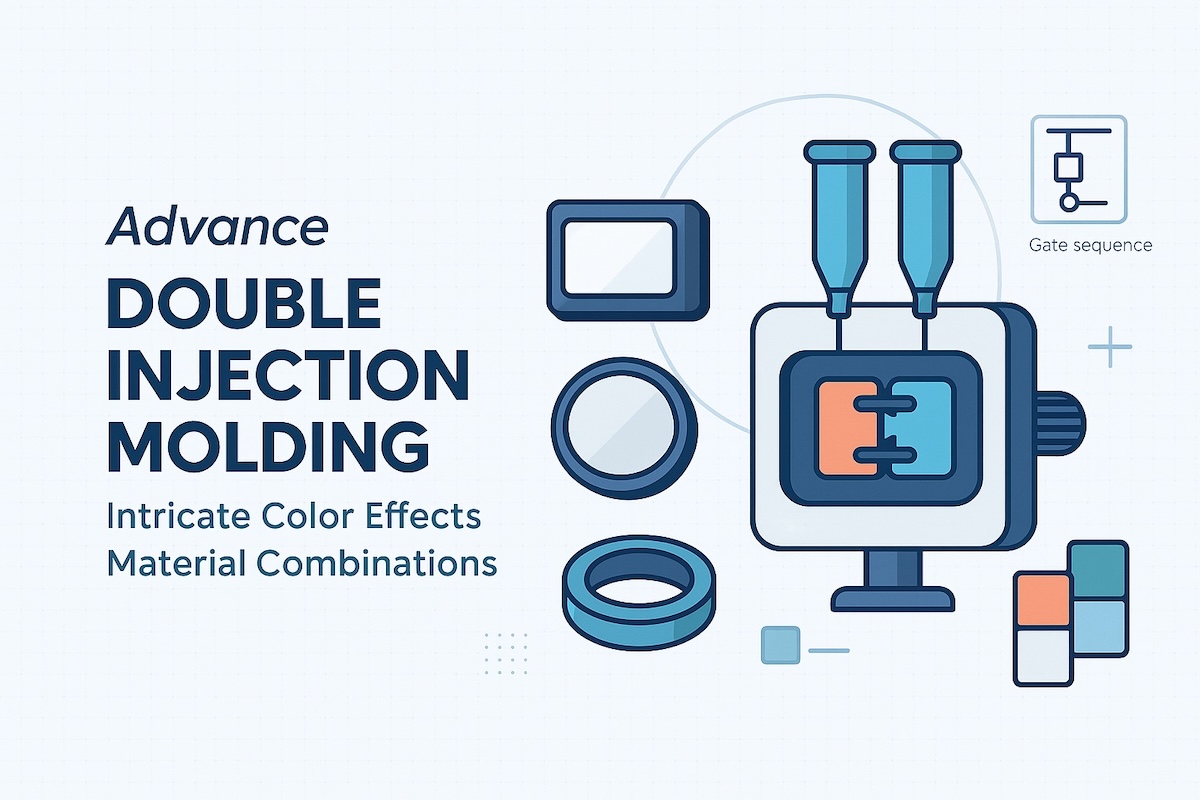Advance Double Injection Molding for Intricate Color Effects and Material Combinations
Advance Double Injection Molding for Intricate Color Effects and Material Combinations

Advance Double Injection Molding for Intricate Color Effects and Material Combinations
Two-shot tooling • Bi-color aesthetics • Soft–hard integration
Double injection molding—also called two-shot or 2K molding—shoots two different materials or colors into a single tool to produce a finished, multi-material part in one cycle. From bi-color logos and day/night icon effects to sealed soft-touch edges on rigid frames, 2K reduces part count, improves reliability, and elevates brand cosmetics.
Explore our end-to-end path from DFM to tooling to automated production:
Custom Mold & Design Maker • Mold Service • Injection Mold • Molding • Customer Examples • Contact
Why Double Injection (2K) Instead of Single-Shot + Assembly?
-
Aesthetic freedom: crisp bi-color borders, in-mold brand marks, backlit day/night icons, light pipes with opaque masks.
-
Functional integration: soft seals, vibration dampers, tactile grips, snap-fit gaskets—without adhesives or secondary assembly.
-
Reliability & compliance: chemical + mechanical interlocks create a durable interface with fewer leak paths.
-
Cost & speed: one tool, one cell, one cycle—fewer fixtures, less WIP, faster changeovers.
See comparable outcomes: Customer Examples
Choose the Right 2K Architecture
-
Rotary platen (turntable): Shot-1 in cavity A → rotate → Shot-2 in cavity B. Fast and compact for medium/large volumes.
-
Index plate / core-back: Moves steel to open overmold zones; ideal for large panels and deep seals.
-
Transfer robot: Moves Shot-1 to station 2; flexible for pilots or very different shots.
-
Thermoplastic + LSR hybrid: Hard substrate plus liquid silicone rubber for medical/wearables.
We compare architectures and ROI in a 48-Hour 2K DFM Pack.
→ Custom Mold & Design Maker
Material & Color Pairings That Work (and Why)
| Substrate (Shot-1) | Overmold/2nd Color (Shot-2) | Typical Use | Notes |
|---|---|---|---|
| PC / PC-ABS | TPE/TPU (PC-bonding grade) | Grips, sealed frames | Strong adhesion; guard against stress cracking |
| ABS | TPE/TPU (ABS-bonding) | Consumer bezels | Paint/print friendly on ABS side |
| PP (homo/random) | TPE/TPV (PP-bonding) | Appliance seals, hinges | Very cost-effective, recyclable mono-family |
| PA6/PA66 (±GF) | TPU/TPE (PA-bonding) | Auto/I&O internals | Manage moisture conditioning for dimension stability |
| PC (clear) | PC (opaque) | Day/night icons, light pipes | Same family for optical clarity + color mask |
| ABS/PC-ABS | ABS/PC-ABS (different color) | Bi-color shells | Sharp color lines with proper shut-offs |
| Thermoplastic | LSR | Medical wearables | Primer/tie-layer or special grades required |
Resin trade-offs, tool steel & surface choices: Injection Mold
DFM Rules for Sharp Color Lines & Strong Bonds
-
Interface geometry: add wrap-around ribs, windows, and micro-steps to create mechanical lock; avoid bond lines < 0.4 mm for most TPEs.
-
Color separation: include a shadow line or tiny step to hide tolerance and prevent color bleed.
-
Gates: gate the structural (hard) shot for flow; gate the cosmetic (soft/2nd color) opposite A-surfaces to minimize flow marks.
-
Venting & shut-offs: polish shut-offs at the color boundary; micro-vent at end-of-fill to avoid burns.
-
Walls & ribs: keep uniform walls; ribs ≈ 40–60% of wall; core-heavy bosses to prevent sink—especially under translucent areas.
-
Draft & ejection: protect A-surfaces across both shots; plan EOAT contact away from color lines.
Get a ready-to-quote DFM with moldflow + cooling map:
→ Custom Mold & Design Maker
Tooling & Cell Details That Pay Back
-
Dual hot runners with valve gates for both shots; sequential valves to relocate welds and sharpen visuals.
-
Cooling balance: each shot with ΔT ≤ 5 °C; conformal-cooled inserts at hot spots to control warp and reduce cycle.
-
EOAT & transfers: soft grippers and poka-yoke nests; verify orientation before Shot-2.
-
Vision seam control: 2D/3D cameras check flash, mismatch, and color line quality; ΔE monitoring for brand colors.
-
Data layer: cavity pressure sensors, DOE-based windowing, and MES dashboards (OEE, CpK @ CTQs, scrap, kWh/kg, genealogy).
On-press integration & automation: Molding
Color Management for Brand-Grade Cosmetics
-
Define masterbatch %, pellet handling, and residence-time limits (prevents hue drift).
-
Use ΔE targets and light-booth checks on critical faces; sample per lot and per cavity.
-
For backlit icons: set translucency spec, wall path, and mask thickness for uniform luminance.
See color control in practice: Customer Examples
Validation & Tests (Make It Defensible)
-
Bond tests: peel/shear at multiple interface sites and after thermal cycling/chemical splash if applicable.
-
Process correlation: weight ladders for gate freeze; cavity-pressure curves to set V/P transfer on Shot-1 and Shot-2.
-
Capability: CpK ≥ 1.67 at CTQs for seam location, cosmetic zones, and critical fits.
-
Documentation: FAIR, CMM/scan, GR&R, ΔE/gloss, seam-vision rules embedded in MES.
Typical Wins You Can Expect*
| KPI | Before (single-shot + assembly) | After (2K optimized) |
|---|---|---|
| Part count per SKU | 2–3 | 1 integrated |
| Assembly labor | High | Near zero |
| Cosmetic rejects at seams | 2.0–3.0% | ≤ 1.0–1.2% |
| Cycle per finished part | 2 cycles + handling | 1 in-tool cycle |
| OEE | 70% | 88–92% |
*Representative; actuals depend on geometry, resin, and tool design.
Examples by category: Customer Examples
RFQ Template (Copy/Paste)
Subject: RFQ – Double Injection (2K) Molding for Bi-Color / Multi-Material Part
Attachments: STEP/IGES + 2D with CTQs & cosmetic map
-
Volumes (pilot → ramp), color SKUs, and target SOP date
-
Shot-1 substrate & Shot-2 overmold/second color (grade/MFR; bonding family)
-
Interface intent (seal, grip, icon, light pipe); peel/shear targets and tests
-
Cosmetic keep-outs; seam location; A-surface texture (SPI) & ΔE/gloss targets
-
Architecture preference (rotary platen / index plate / transfer robot); cavity count
-
Hot runner strategy (valve/sequential), conformal-cooling candidates
-
Inspection pack (FAIR, CMM/scan, bond tests, capability @ CTQs)
-
Automation scope (EOAT, in-cell mark/weld/leak, vision seam)
-
Data & traceability (MES, genealogy, energy kWh/kg)
-
Milestones (T0/T1/buy-off/SOP) & Incoterms
We’ll turn this into a 48-Hour 2K DFM & Cost Pack.
→ Contact • Or start here: Custom Mold & Design Maker
Why TaiwanMoldMaker.com for Double Injection
-
Tooling depth: rotary/index/core-back solutions, dual valve-gated manifolds, conformal cooling, serviceable inserts.
-
Material & color expertise: PC/ABS-TPE, PP-TPV, PA-TPU, clear + opaque PC for day/night icons.
-
Smart cells: EOAT transfers, vision seam control, cavity-pressure sensors, MES dashboards for OEE/CpK/scrap/kWh/kg.
Explore the stack and see results:
Injection Mold • Molding • Customer Examples
Call to Action
Ready to launch double injection molding with sharp color lines and production-grade bonds? Send CAD and targets to receive a 48-Hour 2K DFM & Cost Pack—architecture recommendation, interface design, cooling/gating model, and a bond-validation plan.
→ Request an Instant Quote








